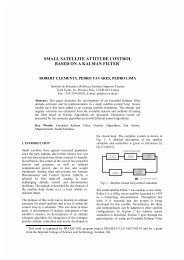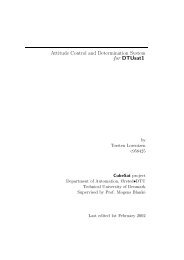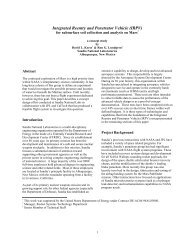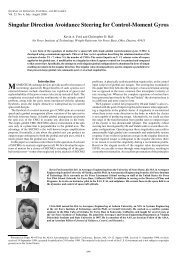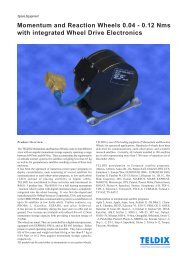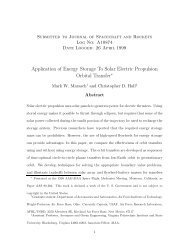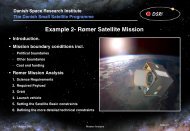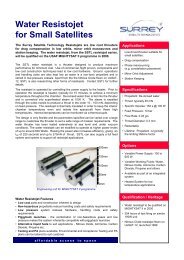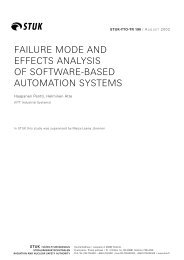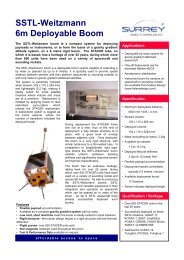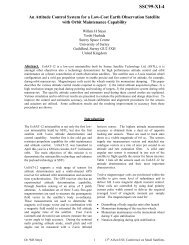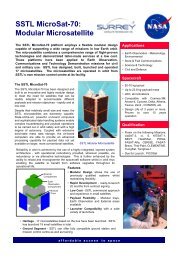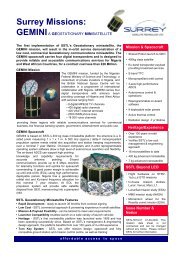- Page 1 and 2: SM® User’s Guide _______________
- Page 3 and 4: TABLE OF CONTENTS 1. INTRODUCTION .
- Page 5 and 6: Mission manager and team ..........
- Page 7 and 8: 6.2 Modal Frequencies..............
- Page 9 and 10: Weather conditions ................
- Page 11 and 12: 11.2 Safety Assessment Phases......
- Page 13 and 14: LIST OF FIGURES Page 1-1 Generic In
- Page 15 and 16: 8-16 Payload Unit Mating to the Zen
- Page 17 and 18: ABBREVIATIONS AND ACRONYMS ACS ARS
- Page 19 and 20: 1. INTRODUCTION Purpose The purpose
- Page 21 and 22: Milestones • Customer kickoff •
- Page 23 and 24: Sea Launch Company Sea Launch Compa
- Page 25 and 26: KB Yuzhnoye/PO Yuzhmash KB Yuzhnoye
- Page 27 and 28: 2. VEHICLE DESCRIPTION Overview The
- Page 29 and 30: Table 2-1. Flight History Component
- Page 31 and 32: RD-171 engine The RD-171 engine, wh
- Page 33 and 34: Block DM-SL interface plane Liquid
- Page 35 and 36: 2.3 Block DM-SL—Upper Stage Confi
- Page 37 and 38: Attitude control Three-axis stabili
- Page 39 and 40: Spacecraft adapter Payload structur
- Page 41 and 42: Cooling air From encapsulation to l
- Page 43 and 44: 3. PERFORMANCE Overview The Zenit-3
- Page 45 and 46: 20 N HAWAIIAN ISLANDS North Pacific
- Page 47 and 48: Flight timeline Table 3-1 lists the
- Page 49: Groundtrack Figure 3-3 shows the as
- Page 53 and 54: Circular and elliptical orbits Figu
- Page 55 and 56: High-energy and escape orbits Figur
- Page 57 and 58: 3.5 Spacecraft Separation Separatio
- Page 59 and 60: Mid 2002 6700 Planned future growth
- Page 61 and 62: Mid 2002 6700 Planned future growth
- Page 63 and 64: Mid 2002 6700 Planned future growth
- Page 65 and 66: Planning Phase (Through SC Delivery
- Page 67 and 68: 4.2 Mission Analysis and Operations
- Page 69 and 70: SC/SLS ICD SC ICD verification plan
- Page 71 and 72: Mission-specific documentation The
- Page 73 and 74: Operations plan The operations plan
- Page 75 and 76: 5.1 Transportation and Handling at
- Page 77 and 78: Vertical Horizontal Horizontal 2658
- Page 79 and 80: Base acceleration, g 1.2 1.0 0.8 0.
- Page 81 and 82: 135 130 Sound pressure levels, dB 1
- Page 83 and 84: SCA1666 The shock spectrum shown in
- Page 85 and 86: 5.6 Electromagnetic Environment The
- Page 87 and 88: Radiated environment There are six
- Page 89 and 90: 200 180 160 140 Electric field, dB
- Page 91 and 92: Ground processing and transportatio
- Page 93 and 94: Ground processing and transportatio
- Page 95 and 96: 1200 PLF separation 1000 Block DM M
- Page 97 and 98: 120 100 Legend: Predicted internal
- Page 99 and 100: Contamination control during ground
- Page 101 and 102:
Spacecraft isolation The spacecraft
- Page 103 and 104:
6. SPACECRAFT DESIGN CONSIDERATIONS
- Page 105 and 106:
6.1 Mass and Center of Gravity (CG)
- Page 107 and 108:
Table 6-2. Expected Spacecraft Mass
- Page 109 and 110:
7000 6000 5000 Spacecraft mass, kg
- Page 111 and 112:
■ Sea Launch RF Susceptibility 16
- Page 113 and 114:
6.4 Spacecraft Design Verification
- Page 115 and 116:
Static loads test A spacecraft stat
- Page 117 and 118:
6.5 Horizontal Handling Processing
- Page 119 and 120:
7. INTERFACES 7.1 Mechanical Interf
- Page 121 and 122:
360 deg 180 deg 331 deg 180 deg 360
- Page 123 and 124:
SCA702 and SCA702GEM The SCA702 has
- Page 125 and 126:
7.2 Electrical Interfaces Overview
- Page 127 and 128:
Radio frequency link (rerad) A dire
- Page 129 and 130:
8. SPACECRAFT INTEGRATION AND LAUNC
- Page 131 and 132:
Days 1 2 3 4 5 6 7 8 9 101112131415
- Page 133 and 134:
Figure 8-5. Fit Check on Adapter Su
- Page 135 and 136:
Payload mount assembly Flexure Inte
- Page 137 and 138:
34 inches 688-95510-002 Scaffold as
- Page 139 and 140:
265807J3-105 Figure 8-13. Payload U
- Page 141 and 142:
8.2 Phase II⎯Mating to the LV and
- Page 143 and 144:
Figure 8-17. Integrated Launch Vehi
- Page 145 and 146:
8.3 Phase III⎯Transit and Launch
- Page 147 and 148:
Launch rehearsals Two rehearsals ar
- Page 149 and 150:
Figure 8-23. Assembly and Command S
- Page 151 and 152:
Figure 8-24. Liftoff From the Launc
- Page 153 and 154:
8.4 Flight Operations Range trackin
- Page 155 and 156:
Postlaunch reports Sea Launch provi
- Page 157 and 158:
■ Integrated LV Transfer to LP Pi
- Page 159 and 160:
265807J3-015R2 Figure 9-3. Home Por
- Page 161 and 162:
Encapsulation cell 15 m x 38 m (50
- Page 163 and 164:
Encapsulation cell The encapsulatio
- Page 165 and 166:
9.2 Assembly and Command Ship Funct
- Page 167 and 168:
Spacecraft checkout accommodations
- Page 169 and 170:
Capabilities Launch control center
- Page 171 and 172:
Customer office areas The two offic
- Page 173 and 174:
265807J3-128 Figure 9-15. Assembly
- Page 175 and 176:
■ Mess Hall ■ Coffee Bar ■ Ma
- Page 177 and 178:
Launch vehicle in launch position L
- Page 179 and 180:
Communications and access Telephone
- Page 181 and 182:
Communications Internal communicati
- Page 183 and 184:
Helicopter operations Sea Launch op
- Page 185 and 186:
10.2 Telemetry Assets Overview Sea
- Page 187 and 188:
Tracking and data relay satellite s
- Page 189 and 190:
Customer responsibilities The custo
- Page 191 and 192:
Phase II⎯ development The custome
- Page 193 and 194:
FAA/AST compliance All launch licen
- Page 195 and 196:
12. SYSTEM RELIABILITY Overview Sea
- Page 197 and 198:
APPENDIX A User Questionnaire When
- Page 199 and 200:
Spacecraft Orbit Parameters SI Unit
- Page 201 and 202:
Effective isotropic radiated power
- Page 203 and 204:
In-flight discrete commands Number
- Page 205 and 206:
Dynamic Environment Allowable accel
- Page 207 and 208:
Ground Processing (continued) Stand
- Page 209 and 210:
Ground Processing (continued) LP (t
- Page 211 and 212:
APPENDIX B. SEA LAUNCH STANDARD OFF
- Page 213 and 214:
Meetings and reviews • Customer k
- Page 215 and 216:
Mission integration Analyses The fo
- Page 217 and 218:
HP facilities • Processing and fu
- Page 219 and 220:
ACS shared areas • Launch control
- Page 221 and 222:
LP security • Card readers will c
- Page 223:
Facilities • Use of additional of



